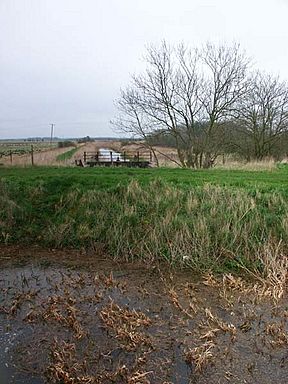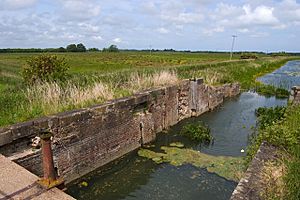Leven Canal facts for kids
The Leven Canal is a historic waterway in England. It stretches about 3.18 miles (5.1 km) from the River Hull to the village of Leven, East Riding of Yorkshire. Built in 1805, it was used for boats until 1935. Today, it is a special place for nature, known as a Site of Special Scientific Interest.
Contents
Leven Canal: A Historic Waterway
Where is the Leven Canal?
The Leven Canal starts at the River Hull, between the areas of Arram and Aike. It ends at the south side of Leven village. The canal runs next to the Leven Carrs in the north. To the south, it borders Eske and Routh Carrs. As it reaches Leven, it goes past Little Leven. Just upstream on the River Hull, you can find the start of the Driffield Navigation.
- The canal is located on the River Hull.
- Upstream (further up the river) is Aike Beck.
- Downstream (further down the river) is Arram Beck.
Building the Leven Canal
People first thought about building a canal to Leven in 1786. The land west of Leven was very wet. It had been drained by the Holderness Drain in the 1760s. This drain ran next to the River Hull and flowed into the Humber Estuary.
Who Owned and Built It?
In 1801, there were two ideas for canals to Leven. One was a large project, but the other was simpler. This simpler plan was for a canal running east from the River Hull to Leven. It was to be paid for by a private person, Mrs Charlotta Bethell.
Mrs Charlotta Bethell was a widow who owned a lot of land in the East Riding of Yorkshire. She asked William Jessop, a famous canal engineer, to survey the land in 1799. Jessop had worked on the Holderness Drainage scheme before. He estimated the canal would cost about £4,041. The drainage officials wanted a second opinion. Mrs Bethell then hired James Creasey. His report agreed with Jessop's. Both said the canal would not harm the area's drainage. With their approval, Mrs Bethell received permission from Parliament on 21 May 1801 to build the canal.
How the Canal Was Built
The Leven Canal opened in 1805. However, it cost more than Jessop had estimated. So, the fees for using the canal had to be increased. This was allowed by a second law passed on 5 June 1805.
A special lock was built where the canal met the River Hull. This lock could hold large boats called keels, which were about 64 by 14.8 feet (19.5 by 4.5 m). The lock had three sets of gates. Two gates worked like a normal lock when the river was higher than the canal. The third gate acted as a flood gate when the river was lower. Later, a fourth set of gates was added. This allowed the lock to be used no matter the river's tide level.
Mrs Bethell's son, Richard, helped pay for improvements to Hull Bridge. This bridge was important for boats coming from Kingston upon Hull. He did this on one condition: the Driffield Navigation had to lower its fees by 60 percent. This saved a lot of money for goods traveling to Leven.
The canal was about 3.25-mile (5.2 km) long. It allowed Humber Keels to reach the storage buildings at Canal Head in the village. One of the two original warehouses, built in 1825, is still there. It has been changed into a private home.
Boats brought in coal, lime, and building materials. Local farm products were sent down the river to Hull.
People of the Canal
The Leven Canal was special for a few reasons. It was quite unusual for a woman to own a canal back then. Even more unique, it had a female lock keeper.
The Lock Keeper's Story
Matilda Simpson was the lock keeper. She was born on 7 August 1814. Her exact birthplace is a bit unclear from old records. Matilda married David Simpson on 23 June 1834 in Leven.
In 1851, the census showed William Simpson, aged 75, as the lock keeper. He lived at the lock house with his wife, Margaret, and their son David. David's wife, Matilda, also lived there. With children and other family, 12 people lived in the lock house!
It is believed that David took over as lock keeper when his father William died in 1853. Sadly, David and his son, John, drowned in a terrible accident. A newspaper reported this on 9 November 1872. David and his son had visited Beverley. David walked back, but his son and his son's wife took a train. It was a very stormy and dark night. A small boat they used as a ferry was tied to the river bank. The son's wife did not want to cross in the small boat. David's son crossed to get a larger boat. On his way back with his father, they both fell into the rough water and died.
The Canal Today
The canal was very busy for many years. But traffic started to slow down in the 1930s. It was officially closed in 1935.
Why Did the Canal Close?
Eventually, the lock stopped being used. The Leven Canal became cut off from the river. The lock, which had three sets of gates, was changed into a sluice. A sluice is a gate that controls water flow. This allowed water to pass into the River Hull.
The canal was sold in 1963 for £1,950. It was bought by Frank Hopkinson, a motor dealer. He joined a group interested in waterways. Mr Hopkinson passed away in 1969. Today, Trailer & Marina (Leven) Ltd manages the canal.
The canal was cut in half at one point. This happened when people decided not to keep up the aqueduct over the "Old Sal" or Holderness Drain. An aqueduct is like a bridge that carries water. Now, a pipe carries water over the drain instead of the canal bed. This pipe is part of the flood defense system for this low-lying area. About 55 yards (50 m) of the canal next to this pipe bridge has been filled in.
Nature's Home: A Special Place
The rest of the canal still has water. It has been a Site of Special Scientific Interest since 1962. This means it's a very important place for nature. The canal supports about 42 types of plants and animals. These include beautiful yellow and white water lilies. This number is higher than in other similar places.
Because of its rich plant and animal life, a court ruled in 2004 that the canal owners could not develop it for fishing or boating. However, some small improvements have been made since then. This was needed because reeds were growing too much and blocking the waterway.
Canal Route Highlights
The aqueduct at Sandholme Farm is an interesting feature. It carries the canal over a drainage ditch that was there before the canal was built. This aqueduct is mostly made of red bricks and has three rounded arches. It is a Grade II listed building, meaning it's historically important.
| Point | Coordinates (Links to map resources) |
OS Grid Ref | Notes |
|---|---|---|---|
| Junction with River Hull | 53°53′24″N 0°23′38″W / 53.890°N 0.394°W | TA056449 | Start of canal |
| Holderness Drain aqueduct | 53°53′24″N 0°21′29″W / 53.890°N 0.358°W | TA079450 | |
| Leven wharf | 53°53′20″N 0°19′05″W / 53.889°N 0.318°W | TA106449 | End of the canal |



